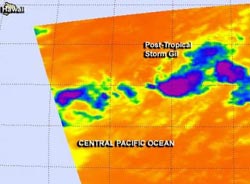Infrared NASA image revealed fading Gil's warming cloud tops

This Aug. 6 infrared image from AIRS on NASA's Aqua satellite showed that cloud top temperatures in Tropical Storm Gil were warming, a sign the storm was weakening.<br><br>Credit: NASA/JPL<br>
The Atmospheric Infrared Sounder or AIRS instrument captured an infrared picture of Tropical Storm Gil on Aug. 6 at 22:59 UTC (6:59 p.m. EDT). The AIRS data showed that cloud top temperatures had warmed since the day before, indicating that the thunderstorms that make up the tropical cyclone didn't have as much punch, or uplift to form more powerful storms.
AIRS imagery is false-colored to show temperature and is created at NASA's Jet Propulsion Laboratory in Pasadena, Calif.
The last advisory on what is now Post-Tropical Cyclone Gil was issued on Aug. 7 at 0300 UTC (11 p.m. EDT on Aug. 6), by NOAA's Central Pacific Hurricane Center. At that time, Gil's maximum sustained winds were down to 30 knots.
Gil was centered about 935 miles east-southeast of Hilo, Hawaii, near 13.5 north and 142.5 west. Gil was moving west-northwest at 6 knots.
Gil has ceased to qualify as a tropical cyclone and its remnants are expected to continue moving in a westerly direction far south of Hawaii.
Media Contact
More Information:
http://www.nasa.govAll latest news from the category: Earth Sciences
Earth Sciences (also referred to as Geosciences), which deals with basic issues surrounding our planet, plays a vital role in the area of energy and raw materials supply.
Earth Sciences comprises subjects such as geology, geography, geological informatics, paleontology, mineralogy, petrography, crystallography, geophysics, geodesy, glaciology, cartography, photogrammetry, meteorology and seismology, early-warning systems, earthquake research and polar research.
Newest articles

Making diamonds at ambient pressure
Scientists develop novel liquid metal alloy system to synthesize diamond under moderate conditions. Did you know that 99% of synthetic diamonds are currently produced using high-pressure and high-temperature (HPHT) methods?[2]…

Eruption of mega-magnetic star lights up nearby galaxy
Thanks to ESA satellites, an international team including UNIGE researchers has detected a giant eruption coming from a magnetar, an extremely magnetic neutron star. While ESA’s satellite INTEGRAL was observing…

Solving the riddle of the sphingolipids in coronary artery disease
Weill Cornell Medicine investigators have uncovered a way to unleash in blood vessels the protective effects of a type of fat-related molecule known as a sphingolipid, suggesting a promising new…





















